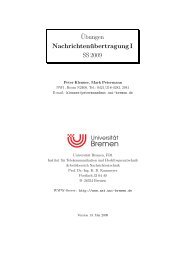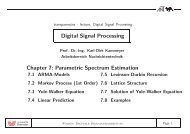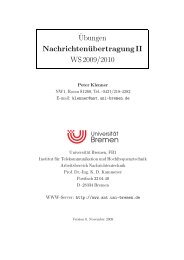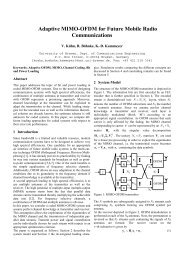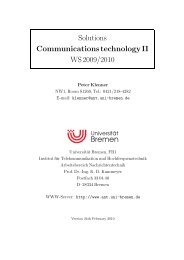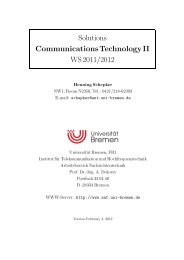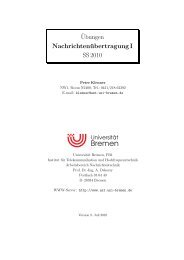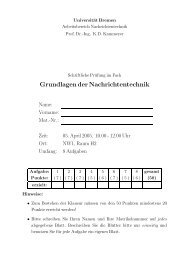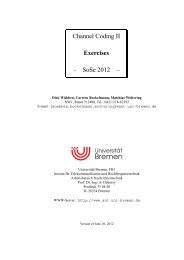Exercises Communications Technology II WS 2010/2011
Exercises Communications Technology II WS 2010/2011
Exercises Communications Technology II WS 2010/2011
You also want an ePaper? Increase the reach of your titles
YUMPU automatically turns print PDFs into web optimized ePapers that Google loves.
<strong>Exercises</strong><br />
<strong>Communications</strong><strong>Technology</strong><strong>II</strong><br />
<strong>WS</strong><strong>2010</strong>/<strong>2011</strong><br />
Yidong Lang, Henning Schepker<br />
NW1, Room N2350, Tel.: 0421/218-62393<br />
E-mail: lang/schepker@ant.uni-bremen.de<br />
Universität Bremen, FB1<br />
Institut für Telekommunikation und Hochfrequenztechnik<br />
Arbeitsbereich Nachrichtentechnik<br />
Prof. Dr.-Ing. A. Dekorsy<br />
Postfach 33 04 40<br />
D–28334 Bremen<br />
WWW-Server: http://www.ant.uni-bremen.de<br />
Version December 15, <strong>2010</strong>
I <strong>WS</strong> <strong>2010</strong>/<strong>2011</strong><br />
“<strong>Communications</strong> <strong>Technology</strong> <strong>II</strong>” – <strong>Exercises</strong><br />
Contents<br />
1 Equalization 1<br />
Exercise 1 (eq03): DFE-Equalizer . . . . . . . . . . . . . . . . . . . . . . . 1<br />
Exercise 2 (eq08): Equalizer, T-spaced, T/2-spaced . . . . . . . . . . . . . . 3<br />
Exercise 3 (eq09): Equalizer, T-spaced . . . . . . . . . . . . . . . . . . . . . 4<br />
Exercise 4 (eq11): Non-linear Equalization . . . . . . . . . . . . . . . . . . . 5<br />
Exercise 5 (eq12): Linear Equalizer . . . . . . . . . . . . . . . . . . . . . . . 6<br />
2 Viterbi 7<br />
Exercise 6 (vit01): Viterbi for QPSK . . . . . . . . . . . . . . . . . . . . . . 7<br />
Exercise 7 (vit08): Viterbi-Detection . . . . . . . . . . . . . . . . . . . . . . 8<br />
Exercise 8 (vit10): Viterbi . . . . . . . . . . . . . . . . . . . . . . . . . . . . 9<br />
Exercise 9 (vit14): ISI-Signal Space at QPSK . . . . . . . . . . . . . . . . . 10<br />
Exercise 10 (vit15): Error Event at Viterbi-Detection . . . . . . . . . . . . . 11<br />
3 Mobile Radio Channel 12<br />
Exercise 11 (2007-03-mobrad): Mobile Radio Channel . . . . . . . . . . . . . 12<br />
Exercise 12 (2007-10-mobrad): Mobile Radio Channel . . . . . . . . . . . . . 13<br />
Exercise 13 (2009-10-mobrad): Mobile Radio Channel . . . . . . . . . . . . . 14<br />
4 OFDM 15<br />
Exercise 14 (ofdm03): OFDM Error Probability . . . . . . . . . . . . . . . . 15<br />
Exercise 15 (ofdm04): OFDM . . . . . . . . . . . . . . . . . . . . . . . . . . 16<br />
Exercise 16 (ofdm05): OFDM . . . . . . . . . . . . . . . . . . . . . . . . . . 17<br />
Exercise 17 (2007-10-6): OFDM . . . . . . . . . . . . . . . . . . . . . . . . 18<br />
Exercise 18 (2009-10-ofdm): OFDM . . . . . . . . . . . . . . . . . . . . . . 19
“<strong>Communications</strong> <strong>Technology</strong> <strong>II</strong>” – <strong>Exercises</strong> <strong>WS</strong> <strong>2010</strong>/<strong>2011</strong> <strong>II</strong><br />
Conventionsand Nomenclature<br />
• All references to passages in the text (chapter- and page numbers) refer to the book:<br />
K.-D. Kammeyer: “Nachrichtenübertragung”, 2.Edition, B. G. Teubner Stuttgart,<br />
1996, ISBN: 3-519-16142-7; References of equations of type (1.1.1) refer to the book,<br />
too, whereas these of type (1) refer to the solutions of the exercises.<br />
• The functions “rect (·)” and “tri(·)” are defined analogous to:<br />
N. Fliege: “Systemtheorie”, 1.Edition, B. G. Teubner Stuttgart, 1991, ISBN: 3-519-<br />
06140-6.<br />
Thus “rect (t/T)” has the temporal expanse T, whereas “tri(t/T)” is not zero for the<br />
length of 2T.<br />
• The letters f and F represent frequencies (in Hertz), ω and Ω angular frequencies (in<br />
rad/s). The following relations are always valid: ω = 2πf resp. Ω = 2πF.<br />
• “δ 0 (t)” denotes the continuous(!) Dirac-pulse, whereas “δ(i)” represents the timediscrete<br />
impulse sequence.<br />
• So called “ideal” low-, band- and highpassfilter G(jω) have value ’1‘ in the respective<br />
passing range and value ’0‘ in the stop range.<br />
• If a time-discrete data sequence d(i) of rate 1/T stimulates a continues filter with<br />
impulse response g(t), it has to be interpreted as<br />
[<br />
]<br />
∞∑<br />
∞∑<br />
x(t) = T d(i) δ 0 (t − iT) ∗ g(t) = T d(i) · g(t − iT).<br />
Abbreviations<br />
i=−∞<br />
i=−∞<br />
ACF auto-correlation function, sequence ISI inter-symbol interference<br />
BW, BB bandwidth, baseband KKF cross-correlation function, sequence<br />
BP bandpass AF audio frequency<br />
DPCM differential PCM PCM pulse-code modulation<br />
F{·} Fourier transform PR partial response<br />
H{·} Hilbert transform S/N = SNR signal-to-noise ratio<br />
HP highpass LP lowpass<br />
Availabilityon Internet<br />
PDF (or PS) -files of the exercises can be downloaded from:<br />
http://www.ant.uni-bremen.de
1 <strong>WS</strong> <strong>2010</strong>/<strong>2011</strong> “<strong>Communications</strong> <strong>Technology</strong> <strong>II</strong>” – <strong>Exercises</strong><br />
1 Equalization<br />
Exercise 1 (eq03): DFE-Equalizer<br />
Exam “<strong>Communications</strong> <strong>Technology</strong>” (University of Bremen) held on 10/12/00<br />
The following symbol clock model of a transmission system is given:<br />
n( i)<br />
Mod.<br />
d( i)<br />
c( i)<br />
+ y( i)<br />
DFE<br />
d( i)<br />
Decod.<br />
QPSK Channel Equalizer<br />
QPSK<br />
The channel has the symbol clock impulse response c(i) = 1 √<br />
2<br />
[1; 1]. After equalization with<br />
decision feedback (DFE) QPSK decoding is applied (Gray coding). At the receiver input an<br />
E b /N 0 of 10 dB has been measured.<br />
a) Draw the block diagram of the equalizer.<br />
b) Find expressions for the received signal y(i) and the signal y q (i) at the detector input,<br />
considering the source data d(i) and the noise n(i), assuming no wrong decisions have<br />
been made.<br />
c) What is the bit error probability at the output of the system assuming that all previous<br />
decisions were correct
“<strong>Communications</strong> <strong>Technology</strong> <strong>II</strong>” – <strong>Exercises</strong> <strong>WS</strong> <strong>2010</strong>/<strong>2011</strong> 2<br />
10 0 x<br />
10 −1<br />
erfc(x)<br />
10 −2<br />
10 −3<br />
10 −4<br />
1 1.2 1.4 1.6 1.8 2 2.2 2.4 2.6
3 <strong>WS</strong> <strong>2010</strong>/<strong>2011</strong> “<strong>Communications</strong> <strong>Technology</strong> <strong>II</strong>” – <strong>Exercises</strong><br />
Exercise 2 (eq08): Equalizer, T-spaced, T/2-spaced<br />
Exam “<strong>Communications</strong> <strong>Technology</strong>” (University of Bremen) held on 04/10/97<br />
The following transmission line is given:<br />
LTI-Channel<br />
k T/w<br />
d(i) ∈ {+1, −1}<br />
✲<br />
Bitrate 1/T<br />
g(t) ✲ c(t)<br />
✲ h(t) ✟ ✟❄ ✲<br />
y(k)<br />
The transmit channel has the impulse response c(t) = δ 0 (t) + δ 0 (t − T ). The joint impulse<br />
2<br />
response of transmit filter g(t) and receiver filter h(t) is the following triangular impulse:<br />
1<br />
✻<br />
g(t) ∗ h(t)<br />
❅ ❅<br />
❅❅❅❅<br />
T<br />
2T<br />
✲<br />
t<br />
(a) Find the total impulse response<br />
f 2 (k) = g(t) ∗ h(t) ∗ c(t)| t=k<br />
T<br />
2<br />
after sampling with double bit rate at the receiver output (w = 2).<br />
(b) The receive signal y(k) is passed through a T/2-spaced equalizer. The impulse response<br />
of this T/2-equalizer is given by<br />
e T/2 = [0.75 − 0.25] T .<br />
Find the total impulse response at the output of the T/2-equalizer.<br />
(c) At the equalizer output sampling with the bit rate is performed. Specify the sampling<br />
phase such that the total impulse response of b) results in a distortionless system (even<br />
or odd k).<br />
d) As an alternative, a symbol rate equalizer (T-equalizer) is applied. Hence, the receive<br />
filter output is sampled with bit rate 1/T (w = 1). Find the symbol rate impulse<br />
response<br />
f(i) = g(t) ∗ h(t) ∗ c(t)| t=iT .<br />
The coefficients of the T-equalizer are given by<br />
e T = [−0.0008 0.0026 0.6658 − 0.1998] T .<br />
Determine the total impulse response at the output of the T-equalizer.
“<strong>Communications</strong> <strong>Technology</strong> <strong>II</strong>” – <strong>Exercises</strong> <strong>WS</strong> <strong>2010</strong>/<strong>2011</strong> 4<br />
Exercise 3 (eq09): Equalizer, T-spaced<br />
Exam “<strong>Communications</strong> <strong>Technology</strong>” (University of Bremen) held on 04/08/99<br />
The symbol rate model of a transmission system is described by the impulse response<br />
f(i) = δ(i) + α · δ(i − 1) ; α ∈ R , |α| < 1.<br />
The receiver uses a symbol rate equalizer with the impulse response<br />
e(i) = δ(i) − α · δ(i − 1) + α 2 · δ(i − 2) − α 3 · δ(i − 3).<br />
This design is called “Zero Forcing” solution.<br />
a) Find the total impulse response of the symbol rate model and equalizer.<br />
b) Depict the pole-zero plot of the total system.<br />
c) Determine the output (S/N) ISI of the equalizer, as well as the maximum error, which<br />
is caused by inter-symbol interference with two-level transmission.<br />
d) Increase the order of the equalizer to n by continuing the “Zero Forcing” design.<br />
Determine (S/N) ISI (at the equalizer output) depending on α and the order of the<br />
equalizer n.
5 <strong>WS</strong> <strong>2010</strong>/<strong>2011</strong> “<strong>Communications</strong> <strong>Technology</strong> <strong>II</strong>” – <strong>Exercises</strong><br />
Exercise 4 (eq11): Non-linear Equalization<br />
Exam “<strong>Communications</strong> <strong>Technology</strong>” (University of Bremen) held on 10/15/98<br />
The symbol clock model of a transmission channel is characterized by the impulse response<br />
as<br />
f(i) = δ(i) + 0.5 · δ(i − 2).<br />
The data transmission is bipolar. An equalization by means of quantized feedback is realized<br />
at the receiver.<br />
n(i)<br />
d(i)<br />
Channel<br />
x(i)<br />
Entzerrer<br />
y(i)<br />
d(i)<br />
a) Draw the block diagram of the equalizer.<br />
b) Assume a decision error occurs at i − 2. For this case specify the signal y(i) at the<br />
detector input at the time i.<br />
(Hint: A decision error occurs at i − 2, for ˆd(i − 2) = −d(i − 2))<br />
c) Calculate the probability of a subsequent error, if the additive noise n(i) on the<br />
transmission line is symmetrically distributed and has zero mean. What is the influence<br />
of the power of the noise on this probability
“<strong>Communications</strong> <strong>Technology</strong> <strong>II</strong>” – <strong>Exercises</strong> <strong>WS</strong> <strong>2010</strong>/<strong>2011</strong> 6<br />
Exercise 5 (eq12): Linear Equalizer<br />
Exam “<strong>Communications</strong> <strong>Technology</strong>” (TUHH, new DPO) held on 10/06/04 (Problem 5)<br />
The figure below illustrates a discrete time model of a digital communication link in the<br />
equivalent baseband domain. QPSK modulated data, given by<br />
d(i)∈{1 + j, 1 − j, −1 − j, −1 + j},<br />
is transmitted over a frequency selective channel with the impulse response<br />
h(i) = {1, 0.5 · e jπ/4 }.<br />
In order to equalize the channel, a linear equalizer e(i) is applied:<br />
d(i) x(i) y(i)<br />
h(i) e(i)<br />
{<br />
w(i)<br />
(a) Which values may the distorted signal x(i) take Sketch the admissible signal space<br />
points for x(i) in the complex plain.<br />
(b) In order to mitigate the impact of inter-symbol interference (ISI), we apply a linear<br />
filter at the receiver, with the impulse response<br />
e(i) = {1, 0.5 · e j5π/4 }.<br />
Determine the impulse response of the overall system w(i) = h(i) ∗ e(i).<br />
(c) Which values may the equalized signal y(i) take Sketch the admissible signal space<br />
points for y(i) in the complex plain.<br />
(d) Determine and sketch the squared magnitude frequency response of the overall system<br />
w(i) = h(i) ∗ e(i) for 0 < Ω < π. What shape would the squared magnitude frequency<br />
response of the overall system have, if the linear filter is an ideal equalizer with respect<br />
to the channel
7 <strong>WS</strong> <strong>2010</strong>/<strong>2011</strong> “<strong>Communications</strong> <strong>Technology</strong> <strong>II</strong>” – <strong>Exercises</strong><br />
2 Viterbi<br />
Exercise 6 (vit01): Viterbi for QPSK<br />
Exam “<strong>Communications</strong> <strong>Technology</strong>” (TUHH, new DPO) held on 04/10/03 (Problem 7)<br />
Consider a QPSK transmission at symbol rate T with the symbol alphabet<br />
d(i)∈{−1 − j , −1 + j , +1 − j , +1 + j}.<br />
Transmit and receive filter are square-root cosine roll-off filter. Both filters fulfill the 1st<br />
Nyquist criterion. The transmission is characterized by a multipath channel with impulse<br />
response<br />
c(t) = δ(t) + δ(t − T).<br />
The data at the receiver is detected by the Viterbi algorithm.<br />
a) Sketch the Trellis diagram and determine all undistorted signal levels z µν of the state<br />
transistions in a table.<br />
b) Sketch the appropriate path into the Trellis diagram for the symbol sequence given by<br />
d(i) = {1 + j , 1 − j , −1 − j , −1 + j , −1 − j} ; i = 1, · · · , 5<br />
and<br />
d(i) = −1 − j ; i ≤ 0 and i > 5.<br />
c) At the receiver we obtain the sampled signal<br />
y(i) = {0.5 + j , 2 + 0.5j , −3j , −2 , −2 + j} ; i = 1, · · · , 5<br />
after matched filtering. Calculate the sum metric (euclidian distance, “path cost”) of<br />
the path determined in problem b).
“<strong>Communications</strong> <strong>Technology</strong> <strong>II</strong>” – <strong>Exercises</strong> <strong>WS</strong> <strong>2010</strong>/<strong>2011</strong> 8<br />
Exercise 7 (vit08): Viterbi-Detection<br />
Exam “<strong>Communications</strong> <strong>Technology</strong>” (University of Bremen) held on 04/08/99<br />
A data sequence d(i) ∈ {−1, 1} is modulated with a BPSK (symbol length T) and transmitted<br />
on a multipath channel. The transmission and the reception filter are matched, together they<br />
fulfil the 1st Nyquist criterion. The impulse response of the channel is known as:<br />
c(t) = δ(t) + δ(t − T) + 0.5 · δ(t − 2 · T) .<br />
The data is transmitted in blocks, where one block consists of four data bits and two tail bits.<br />
The two tail bits have the value −1. The transmissed data has to be recovered at the receiver<br />
by MLSE.<br />
a) Sketch the appropriate Trellis diagram.<br />
b) After sampling we have the following sequence at the output of the receiver:<br />
ŝ(i) = 1.5; −0.5; −1.5; 2.5; −2.5; 0.5 ; i = 1...6 .<br />
Perform a MLSE using the Trellis diagram from problem a) and mark the approriate<br />
path.<br />
c) Specify the approriate data sequence for i = 1...4.
9 <strong>WS</strong> <strong>2010</strong>/<strong>2011</strong> “<strong>Communications</strong> <strong>Technology</strong> <strong>II</strong>” – <strong>Exercises</strong><br />
Exercise 8 (vit10): Viterbi<br />
Exam “<strong>Communications</strong> <strong>Technology</strong>” (TUHH, new DPO) held on 04/07/04 (Problem 6)<br />
A signal modulated by a linear modulation scheme is transmitted over a radio link and<br />
distorted by a frequency selective multipath channel. After sampling at symbol rate the<br />
Viterbi algorithm is applied, in order to recover the transmitted symbol sequence at the<br />
receiver. The corresponding Trellis diagram is depicted in the figure below.<br />
S 0<br />
S 1<br />
S 2<br />
S 3<br />
S 4<br />
S 5<br />
S 6<br />
S 7<br />
(a) Determine the linear modulation scheme according to the depicted Trellis diagram.<br />
How many taps does the channel have Give the contents of the channel memory for<br />
each state.<br />
(b) Determine the symbol sequence d(i), according to the solid line in the figure.<br />
(c) The dashed line represents an error event. Determine the error vector e and determine<br />
the corresponding S/N loss factor γ<br />
min 2 , if the product of the channel convolution<br />
matrices is given by<br />
⎡<br />
⎤<br />
F H F =<br />
⎢<br />
⎣<br />
1 0 −0.7<br />
0 1 0<br />
−0.7 0 1<br />
⎥<br />
⎦.
“<strong>Communications</strong> <strong>Technology</strong> <strong>II</strong>” – <strong>Exercises</strong> <strong>WS</strong> <strong>2010</strong>/<strong>2011</strong> 10<br />
Exercise 9 (vit14): ISI-Signal Space at QPSK<br />
Exam “<strong>Communications</strong> <strong>Technology</strong>” (University of Bremen) held on 10/06/97<br />
Statistically independent, equally distributed QPSK symbols are transmitted on a channel<br />
with a memory of 1st order. The real-valued symbol clock impulse response of the channel is<br />
given as<br />
f(i) = 0.8 · δ(i) + 0.6 · δ(i − 1) .<br />
Inter-symbol interference (ISI) occurs. The QPSK symbols are taken from the symbol<br />
alphabet<br />
d 1 = 1 √ + j , d 2 = −1 √ + j , d 3 = −1 √ − j , d 4 = 1 √ − j ,<br />
2 2 2 2<br />
which results in the signal space diagram of transmission symbols shown below.<br />
1<br />
QPSK symbols<br />
imag →<br />
0.5<br />
0<br />
-0.5<br />
-1<br />
-1 -0.5 0 0.5 1<br />
real →<br />
a) Sketch the block diagram of the symbol clock model for the transmission channel.<br />
b) Calculate the resulting signal levels w 11 and w 42 at the output of the channel for the two<br />
combinations of input symbols {d(i) = d 1 , d(i − 1) = d 1 } resp. {d(i) = d 4 , d(i − 1) =<br />
d 2 }.<br />
c) Sketch the signal space diagram at the output of the channel which results from all<br />
possible combinations of input symbols. You can avoid further calculations, if you draw<br />
conclusions on the analogy of problem b).<br />
d) Additional task for the exercise (not in the test):<br />
Calculate the average signal powers at the input and output of the channel.
11 <strong>WS</strong> <strong>2010</strong>/<strong>2011</strong> “<strong>Communications</strong> <strong>Technology</strong> <strong>II</strong>” – <strong>Exercises</strong><br />
Exercise 10 (vit15): Error Event at Viterbi-Detection<br />
The Trellis diagram of a 2nd order channel for binary transmission is given, whose data<br />
obviously belong to the alphabet d(i) ∈ {0, 1} .<br />
S 0 = {0,0}<br />
S 1 = {0,1}<br />
S 2 = {1,0}<br />
S 3 = {1,1}<br />
a) Determine the bit sequence that corresponds to the bold path (true data sequence).<br />
b) At the receiver the data sequence corresponing to the dashed path is detected (in the<br />
last part of the Trellis diagram both paths overlap). Determine the error vector.<br />
c) Calculate the energy ACF of the error vector and then use it to determine the 3 × 3<br />
auto-correlation matrix R E ee .<br />
d) Calculate the minimum eigenvalue of the matrix. How big is the S/N loss of the Viterbi<br />
detection compared to a transmission on an AWGN channel
“<strong>Communications</strong> <strong>Technology</strong> <strong>II</strong>” – <strong>Exercises</strong> <strong>WS</strong> <strong>2010</strong>/<strong>2011</strong> 12<br />
3 MobileRadio Channel<br />
Exercise 11 (2007-03-mobrad): Mobile Radio Channel<br />
Three reflected radio signals are received by a car driving with a velocity of v = 100km/h, as<br />
shown in the figure below. The relative delay of the signals can be neglected at first and the<br />
carrier frequency is f 0 = 2 GHz. The reflection coefficients r 0 , r 1 , r 2 are given in the figure<br />
below.<br />
Hint: Speed of light c 0 ≈ 3 · 10 8 m/s<br />
r 1 = 0.6<br />
r 0 = 1<br />
r 2 = 0.3<br />
35 ◦ v<br />
a) Calculate the Doppler frequencies f D,ν of the three signals.<br />
b) Sketch the complete spectrum of the received signal in case of a unmodulated signal.<br />
The velocity of the car shall be v = 0km/h now, so that no Doppler effect occurs. The<br />
reflected path components with reflection coefficients r 1 and r 2 have relative delays τ 1 , τ 2 ,<br />
with τ 2 > τ 1 , with respect to the direct path (τ 0 = 0), with coefficient r 0 .<br />
c) Sketch die impulse response h K (t) of the multipath channel.<br />
d) Give the expression for the impulse response and calculate the channel transfer function<br />
H K (jω) of the multipath channel.<br />
e) At the receiver the received signal is filtered with an ideal bandpass H BP (jω) with<br />
center frequency f 0 and bandwidth B. Calculate the equivalent lowpass description<br />
H TP (jω) of the overall transfer function H(jω) = H K (jω) · H BP (jω).<br />
f) Illustrate the impact of the echos on the absolute transfer function |H TP (jω)|<br />
(Short explanation please!).
13 <strong>WS</strong> <strong>2010</strong>/<strong>2011</strong> “<strong>Communications</strong> <strong>Technology</strong> <strong>II</strong>” – <strong>Exercises</strong><br />
Exercise 12 (2007-10-mobrad): Mobile Radio Channel<br />
Consider a BPSK data transmission, with d(i)∈{−1, 1}, over a flat channel with the timevariant<br />
channel coefficient h(k)<br />
y(k) = h(k) · d(k) + n(k) .<br />
The symbol duration is T Baud = 50 ns, and the signal-to-noise power ratio is E b<br />
N 0<br />
= E{|d(k)|2 }<br />
E{|n(k)| 2 } = 7 dB.<br />
The channel h(k) can assume three states, which are characterized by the channel coefficients<br />
h 1 = 0, 5 · exp(jπ/4), h 2 = 0, 8 · exp(jπ/6), h 3 = 0, 1 + j0, 2 .<br />
Furthermore, the states are characterized by an average probability of occurence P l =<br />
Pr{h(k) = h l } with P 1 + P 2 + P 3 = 1.<br />
Hint: Assume perfect channel state information and coherent detection at the receiver.<br />
Use the graphic below to solve the following problems.<br />
a) Determine the average bit error probability for uniformly distributed states, P 1 = P 2 = P 3 .<br />
b) Determine the average bit error probability for the following probabilities of occurence:<br />
P 1 = 0, 6, P 2 = 0, 3, P 3 = 0, 1 .<br />
c) Asumme perfect channel state transmission at the transmitter. What is the resulting<br />
bit error probability, if the transmitter transmits only during the strongest channel<br />
coefficient<br />
d) Determie the average bit rate for case c).<br />
10 0 x<br />
10 −1<br />
10 −2<br />
10 −3<br />
erfc(x)<br />
10 −4<br />
10 −5<br />
10 −6<br />
10 −7<br />
10 −8<br />
0 0.5 1 1.5 2 2.5 3 3.5 4
“<strong>Communications</strong> <strong>Technology</strong> <strong>II</strong>” – <strong>Exercises</strong> <strong>WS</strong> <strong>2010</strong>/<strong>2011</strong> 14<br />
Exercise 13 (2009-10-mobrad): Mobile Radio Channel<br />
A mobile radio channel scenario is given in the figure below.<br />
l 1 = 1, 4 km<br />
ρ 1 = 0.5<br />
Tx<br />
l 0 = 600 m<br />
ρ 0 = 1<br />
45 ◦<br />
Rx<br />
a) Determine the impulse response of the equivalent low-pass channel for a stationary<br />
vehicle. The carrier frequency is f 0 = 1 GHz.<br />
Hint: Speed of light c 0 = 3 · 10 8 m/s<br />
b) Determine the channel transfer function of the equivalent low-pass channel. Determine<br />
the minimum and the maximum of its absolute value and the corresponding frequencies.<br />
Sketch the absolute value of the transfer function.<br />
c) Now the vehicle has a speed of v = 150 km/h. Give an expression for the received<br />
equivalent low-pass signal r(t) for an arbitrary transmitted low-pass signal s(t).
15 <strong>WS</strong> <strong>2010</strong>/<strong>2011</strong> “<strong>Communications</strong> <strong>Technology</strong> <strong>II</strong>” – <strong>Exercises</strong><br />
4 OFDM<br />
Exercise 14 (ofdm03): OFDM Error Probability<br />
Exam “<strong>Communications</strong> <strong>Technology</strong>” (University of Bremen) held on 10/12/00<br />
An OFDM system with 2048 active subcarriers is used for wireless transmission. The interval<br />
between two subcarriers is 250 Hz and the guard interval has a length of 2 ms. A BPSK<br />
modulation is used for each subcarrier.<br />
a) Determine the bandwith and transmission rate of the entire system.<br />
b) An IDFT with the length 4096 is used to create the OFDM signal. Determine the<br />
sampling frequency of the output signal and how many samples fall into the guard<br />
interval.<br />
c) The required bandpass energy of an OFDM symbol at the transmitter is E OFDM = 1.4<br />
Ws. White Gaussian noise with the power spectrum N 0 /2 = 6 · 10 −5 Ws is added in<br />
the bandpass. Determine the E b /N 0 ratio (in dB). Specify the bit error rate of the<br />
transmission system. Calculate the average power emitted by the transmitter.<br />
Hint: Take possibly needed values of the erfc-function from the graphic in the textbook.
“<strong>Communications</strong> <strong>Technology</strong> <strong>II</strong>” – <strong>Exercises</strong> <strong>WS</strong> <strong>2010</strong>/<strong>2011</strong> 16<br />
Exercise 15 (ofdm04): OFDM<br />
Exam “<strong>Communications</strong> <strong>Technology</strong>” (TUHH, new DPO) held on 04/07/04 (Problem 4)<br />
An OFDM system is operating within a bandwidth of B = 6 MHz on N c = 16 subcarriers<br />
with a bandwidth efficiency of u = 0.8. The transmitted data is modulated by a 8-PSK<br />
scheme.<br />
(a) Determine the data rate R of the system.<br />
(b) How large is the maximum delay τ max for the channel Justify your calculations.<br />
Utilizing the same system parameters, the transmission now uses a data rate of R = 13.5<br />
Mbit/s.<br />
(c) How many of the 16 subcarriers are needed to achieve the given data rate<br />
A channel estimation yields the impulse response given as:<br />
h(k) = 1 · δ(k) + 0.5 · δ(k − 1)<br />
(d) Which subcarriers do you suggest to be switched off<br />
Hint: The center frequency of the first subcarrier is located at Ω = 0 .
17 <strong>WS</strong> <strong>2010</strong>/<strong>2011</strong> “<strong>Communications</strong> <strong>Technology</strong> <strong>II</strong>” – <strong>Exercises</strong><br />
Exercise 16 (ofdm05): OFDM<br />
Exam “<strong>Communications</strong> <strong>Technology</strong>” (TUHH, new DPO) held on 10/08/03 (Problem 8)<br />
For a wireless computer network (WLAN, Wireless Local Area Network) an OFDM system<br />
is used. A transmission rate of 32 Mbit/s shall be achieved. The maximum length of the<br />
channel impulse response is 800 ns.<br />
a) Determine the distance of the subcarriers, if the guard interval is 20% of the overall<br />
symbol duration.<br />
b) Calculate the S/N loss due to the insertion of the guard interval (Violation of the<br />
matched-filter criterion!).<br />
c) The bandwidth of the channel is 20 MHz. Of how many subcarriers does the transmitted<br />
signal consist<br />
d) From the modulation methods BPSK, QPSK, 8PSK, 16QAM, and 64QAM choose the<br />
one that just reaches the required transmission rate. Give a calculation for justyfication.
“<strong>Communications</strong> <strong>Technology</strong> <strong>II</strong>” – <strong>Exercises</strong> <strong>WS</strong> <strong>2010</strong>/<strong>2011</strong> 18<br />
Exercise 17 (2007-10-6): OFDM<br />
The upcoming enhancement of the UMTS system is currently specified under the name Long<br />
Term Evolution (LTE), which applies the transmission scheme OFDM. For this technology a<br />
maximum bandwidth of 30.72 MHz and a FFT length of 2048 are specified. The duration of<br />
the OFDM core symbol is specified with 66.67µs, the duration of the cyclic prefix is 16.67µs.<br />
a) State one advantage and one disadvantages of using OFDM as transmission scheme.<br />
b) Determine the subcarrier spacing ∆f and the bandwidth efficiency β. What is the<br />
maximum allowable delay spread of a channel to guarantee that no inter-symbol<br />
interference occurs<br />
c) How many subcarriers must be switched off or allocated with zeros, if a maximum<br />
bandwidth of 18 MHz must not be exceeded Determine the maximum data rate that<br />
can be transmitted with this bandwidth, if 64-QAM modulation is applied.<br />
d) To create the OFDM signal at this bandwidth an IFFT of length 2048 is used.<br />
Determine the sampling frequency at the output of the IFFT and how many sampling<br />
points appear in the guard interval respectively.
19 <strong>WS</strong> <strong>2010</strong>/<strong>2011</strong> “<strong>Communications</strong> <strong>Technology</strong> <strong>II</strong>” – <strong>Exercises</strong><br />
Exercise 18 (2009-10-ofdm): OFDM<br />
An OFDM system with a minimum bitrate of R b = 10 Mbit/s is to be realized. Due to the<br />
channel’s frequency selectivity the subcarrier spacing may not exceed ∆f = 10 kHz. An SNR<br />
loss of γ 2 = −1 dB due to the cyclic prefix is allowed.<br />
a) Determine the maximal duration of the cyclic prefix.<br />
b) Each subcarrier is modulated using QPSK. The cyclic prefix has the duration calculated<br />
in problem a). Determine the number of subcarriers that are required to achieve the<br />
desired bitrate.<br />
c) Implementation constraints demand an FFT length, which is the number of subcarriers<br />
rounded to the next largest power of two. Which sampling frequency do you need to<br />
provide now<br />
d) Determine the maximal data rate when the number of subcarriers is identical to the<br />
FFT-length in problem c).<br />
e) The channel transfer function is to be estimated via scattered pilot symbols. Determine<br />
the maximal spacing ∆n Pi between subsequent pilot symbols in the frequency direction,<br />
if the maximal echo delay of the channel τ max equals the guard duration.



